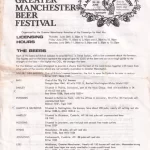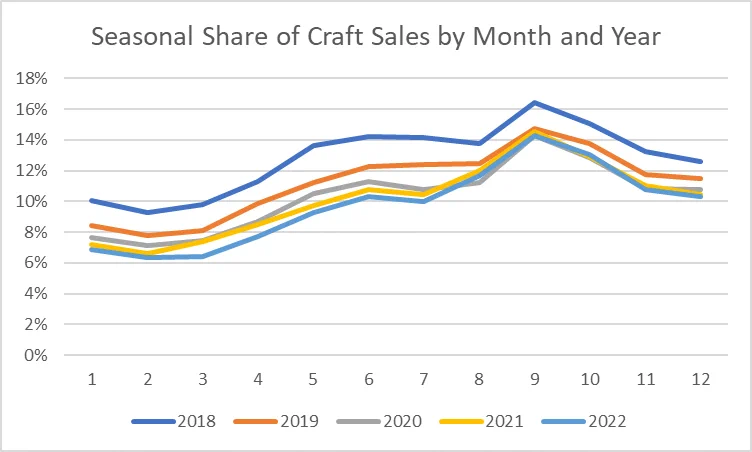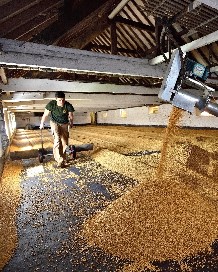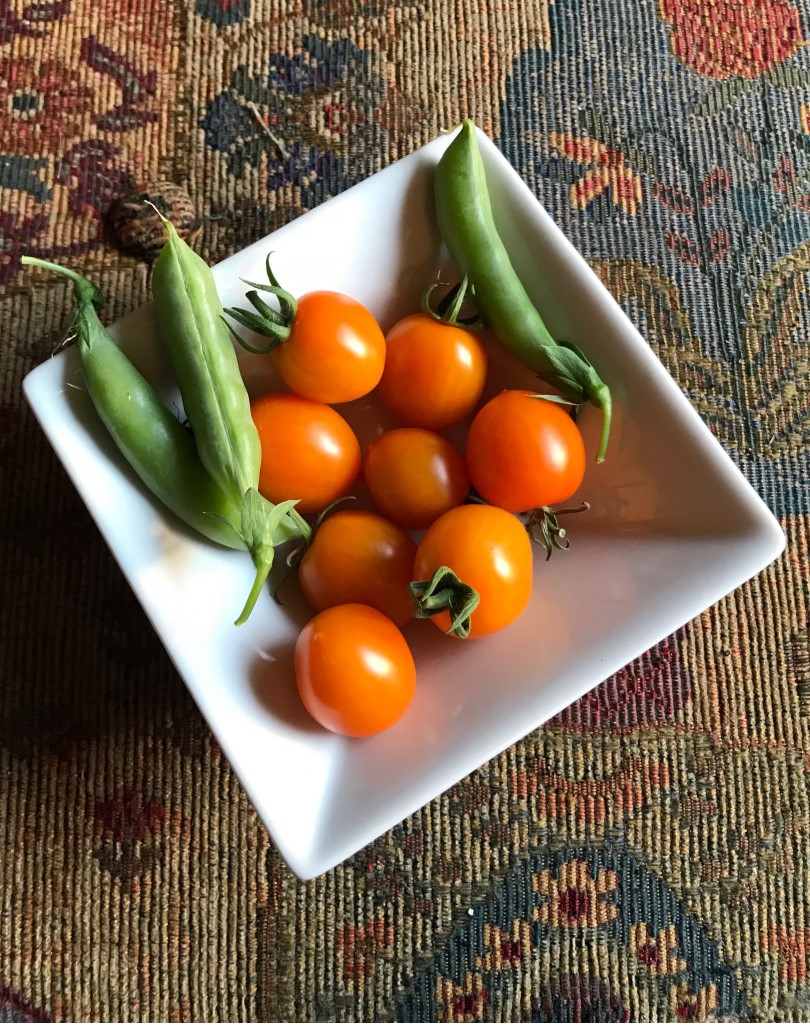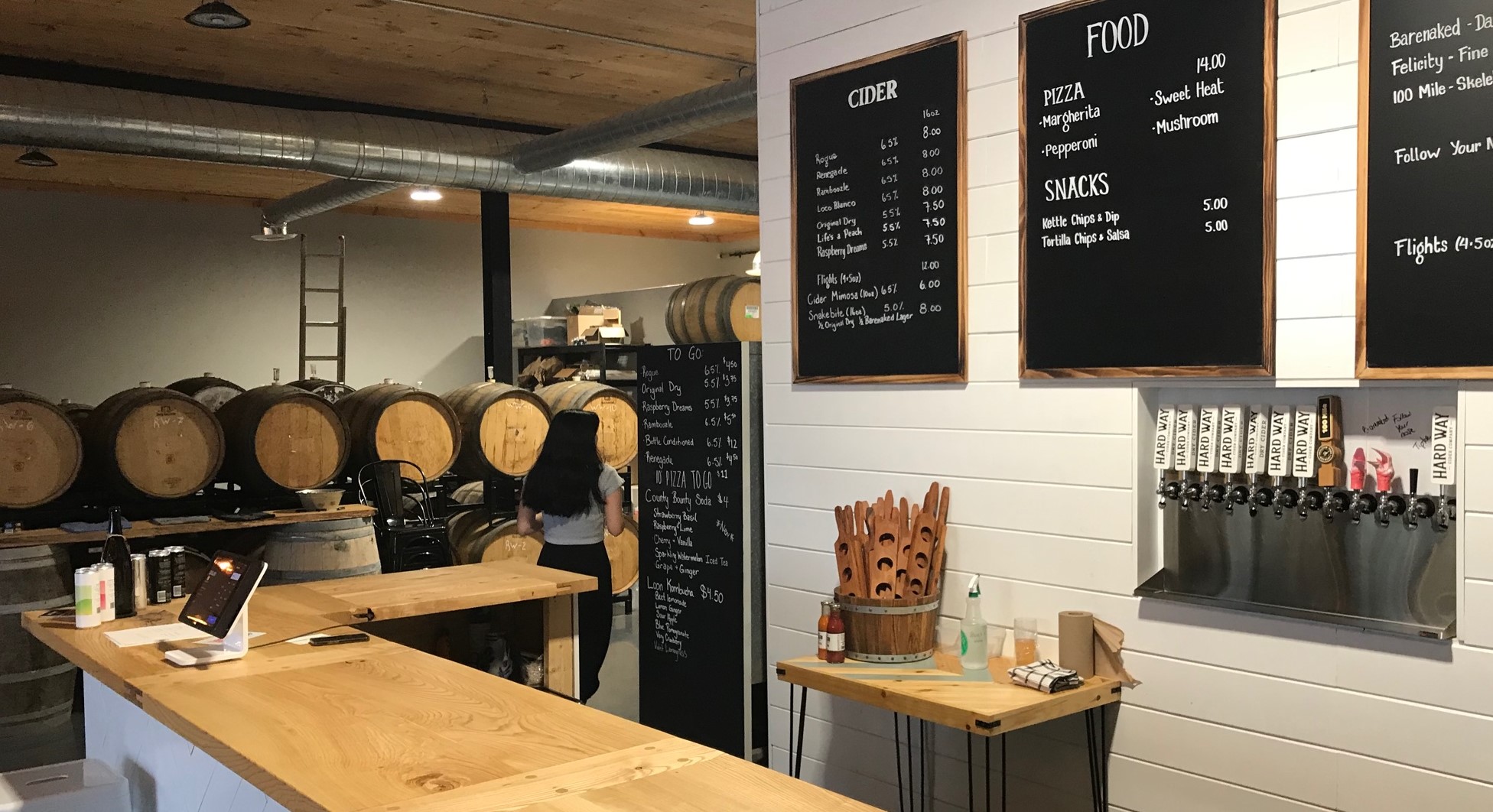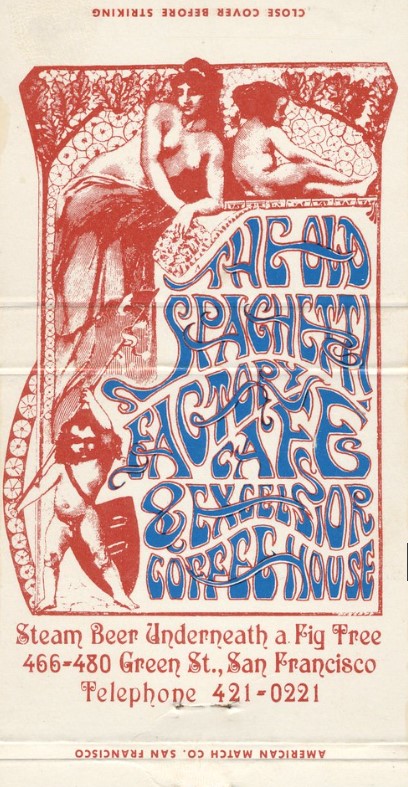 “Gather round family! It’s time to unwrap the boiled turkey from its flannel wrap!!” What joy, what child’s glee can match that wonderful moment when the bird is wrapped in Grandpa’s old work shirt from back on the farm. And, for the Canadian craft beer fan, the annual moment to gloat over how no wine can match flannel boiled turkey than a good old musty stock ale in a can. I love how even the branding is classic Canadiana passive aggressive around this time of year:
“Gather round family! It’s time to unwrap the boiled turkey from its flannel wrap!!” What joy, what child’s glee can match that wonderful moment when the bird is wrapped in Grandpa’s old work shirt from back on the farm. And, for the Canadian craft beer fan, the annual moment to gloat over how no wine can match flannel boiled turkey than a good old musty stock ale in a can. I love how even the branding is classic Canadiana passive aggressive around this time of year:
Extra Old Stock holds a pleasant grain character with a light sweetness. You will enjoy a medium-dry finish with a mild sweet aftertaste.
 Damn right you will. You better. Speaking of things Canadian and agricultural, BA Bart has reported on the continental barley crop:
Damn right you will. You better. Speaking of things Canadian and agricultural, BA Bart has reported on the continental barley crop:
Total N. American barley harvest down 14%. Change mostly driven by lower yields in Canada (better than terrible 2021 but down from last year & 10 year avg).
It’s driven that way in large part because, as the handy graph provided shows, Canadian malt production passed the plummeting annual US crop about forty years ago from a combined high then of just under 1.25 trillion bushels to around 540 billion now. That’s a drop to 43% of peak production. That’s quite the statistic.
Next, an apology to Martyn whose story of the King’s Walden Brewery was published on September 23rd but went unmentioned last week. I note it now for many reasons – but expecially this really interesting bit near the end:
Fellowes went on to be one of a number of British entrepreneurs who invested in American breweries in the 1890s and 1900s: he was on the board of the Bartholomay Brewing Company of Rochester, New York in 1900, and chairman of the company by 1913, and by 1907 he was also a director of the San Francisco Breweries Ltd, an amalgamation of nine Northern Californian concerns. Fellowes was still on both companies’ boards when Prohibition arrived in 1919.
The key facts that I would include on any brewing history exam are: (i) British money poured into the North American brewing industry in the later 1800s seeking large returns, (ii) consolidation along with equipment upgrades was an important means to achieve those returns and (iii) how many of those amalgamated nine breweries were steam breweries… or did the British money pay for steam? Along with trains, this cash influx was a main cause of the retraction in the number of breweries, a phenomenon we see today in US craft but in reverse. Now we have many more breweries making less and less.
Note: If it was in my town, I would spend many hours at the place called Dave’s Pie & Ale House.
Interesting to note that the right-wing bigotry issues continue to dog cask ale in England* all of a sudden. Boak and Bailey unpacked the general nationalist scene:
But in these days of the supposed culture war ‘conservative’ isn’t just about your attitude to economics. It’s also about your stance on feminism, gender, racism, Brexit, vaccination… Nigel Farage, the most prominent champion of Brexit, made pints of cask ale part of his personal image, and the preservation of the crown-stamped pint glass a key talking point of the ‘Leave’ campaign. As beer writers are fond of pointing out, cask ale is uniquely British (terms and conditions may apply) and so lends itself to nationalist posturing. Cask ale is also associated with ‘proper pubs’. For many, a proper pub is the very dream and ideal. For others, it’s an idea loaded with danger signs: doesn’t it just mean white, male and possibly, or probably, racist?
The Drinks Business noted an odd response to the situation: ignore the obvious implications of a botched PR rollout and go straight for some bland messaging by the usual suspects all singing from the well thumbed hymnal, suggesting that the best way to deal with a problem is to deny the problem:
The messages, which came in thick and fast during Cask Ale Week, were in response to the sector feeling that cask assessor Cask Marque’s recent tie up with GB News had done little to amplify the positive aspects of cask. One key message that rang true throughout was that “cask is for everyone” – a turn of phrase which, following the debacle, became a hashtag on Twitter. What then unfolded was a swathe of messages from beer fans and voices from across the industry who set about beginning to preach about cask ale with raptures of how it was such a “perfect” and “comforting” drink, especially when enjoyed in a pub setting.
David calls on the British Guild of Beer Writers to separate themselves from the taint. No perceived groundswell out there. Wouldn’t be comforting. Nope. He addressed the question in his newsletter who uncovered some convoluted weirdness in the accounting department:
As a former director of the Guild, I believe that the members (beer writers) should hold the managers of the institution (the Guild) to account for having problematic sponsors (such as Cask Marque). But what is exactly the role Cask Marque has with the Guild, as their involvement isn’t mentioned on the Guild’s website? I was amazed to discover by the chair of the Guild that “all incoming and outgoing finances go through Cask Marque” despite them not being a corporate sponsor.
WTF??? Do many people know this? So much for an independent press.
Perhaps relatedly in terms of hidden obstacles but certainly interesting, then, to read how one arguably conservative… or is it progressive… institution, London’s 140 years University Women’s Club, which is even now released the legal team to try to achieve parity as reported in The Times:
The club was founded as the University Club for Ladies in 1883 by pioneers of education for women to provide a retreat from the stresses of life with a library and intellectual events. Since 1921 it has been based in a handsome townhouse in Mayfair… In a letter to the City of Westminster council’s licensing committee, they say that councillors must ensure “that the only traditional members club in London dedicated to women and their careers is given comparable privileges to those enjoyed by other traditional clubs dedicated to men”. The lawyers argue that the club “provides direct support to women in their careers, and offers access to a network of unparalleled female talent in a host of industries and fields”. The club is seeking to extend its licence which restricts alcohol sales to between 11am and 11pm and to allow for functions for non-members including music and dancing.
Dancing? Non-members dancing?!? Imagine what that could lead to… And speaking of yes, no maybe so… you can tell it’s no longer summer with the first of the calls for month long no alcohol campaigns. Here’s a story of how US drinker turned a dry month into a year:
The benefits are obvious. I have a higher disposable income, I’m sleeping a lot better, and I’m more focused at work. I’ve gotten through birthdays, weddings, dates and Pride season, all without a drop of alcohol — something I could not have foreseen 12 months ago. There’s also the freedom of not having to think about the next time I’ll potentially embarrass myself by drinking. Sobriety hasn’t solved all my issues. We often hear about the life-changing aspects of putting down alcohol, but doing so also has shed light on the other work I need to do on myself.
Sensible stuff. But the odd thing is… humans embarrassing themselves while not drinking. Or, if we consider the Bangor Daily News out of Maine, non-humans embarrassing themselves while drunk:
Wild berries and other fruit have reached peak ripeness and are falling to the ground. Cold nighttime temperatures concentrate the sugar in the fruit and when it warms up during the day, the sugars break down, forming alcohol. A very potent alcohol. No matter how high the alcohol content, animals and birds rely on the fruit for their fall diet. They consume it, get drunk and behave oddly. But wildlife experts warn that a tipsy animal or bird looks very much like a diseased animal or bird.
That story was just for Stan as once again the elephants have let us down. And surely not related, don’t forget that there is no such thing as a beer expert.
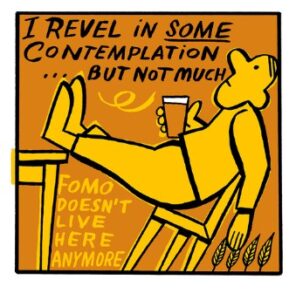 I have to say I am much happier with the new cartoonist at Pellicle, David Bailey.** I think I would have had to spike my tea with catnip to have a clue about the last storyline about cats meant. That right there is but one-twelfth of this month… last months… offering. And now that the monthly funnies are back to being about beer, the features essays continue to be all about all things but in the best of ways. This week we read about a subject that has gotten Alistair a bit weepy over the thought of a fishy snack, the prawn sandwiches as the Green Seafood Shack in Oban, Scotland written by Jemma Beedie:
I have to say I am much happier with the new cartoonist at Pellicle, David Bailey.** I think I would have had to spike my tea with catnip to have a clue about the last storyline about cats meant. That right there is but one-twelfth of this month… last months… offering. And now that the monthly funnies are back to being about beer, the features essays continue to be all about all things but in the best of ways. This week we read about a subject that has gotten Alistair a bit weepy over the thought of a fishy snack, the prawn sandwiches as the Green Seafood Shack in Oban, Scotland written by Jemma Beedie:
Tony Ogden always knew he wanted to work in his father’s seafood shack. Known variously as the Green Shack, the Green Seafood Shack, the Original Seafood Shack, the Oban Seafood Hut, Oggy John’s, or any combination of that list, Tony’s shop is the highlight of any trip to the West Coast. Whether taking in Oban’s seaside vibe or jumping on a ferry over to the Inner or Outer Hebrides, it’s an essential stop. A modest shed around the corner from Caledonian MacBrayne’s ferry terminal, so popular it needs no true designation.
While we are out there in the wider world, a question: why does “Czech” get a pass as an adjective for international craft brewers but “Belgian” and certainly “Lambic” do not? We were warned off that sort of appropriation, were we not? Why is “Czech” transportable but “Belgian” is not? Jeff nips around the heels of the question a bit in this article about cloning the dark lagers of Prague:
As Americans have largely turned their backs on darker beers, Czech tmavý is a bit of a cheat code—looks dark, but tastes sweetish and chocolatey, with the smooth drinkability lagers offer. Tmavý—almost always described as “Czech dark lager” in the US—isn’t a giant presence, but it keeps growing incrementally. Yet even where it has found a following, the style remains obscure to most people, and unlike other ur-beers that define their style (Saison Dupont, Schneider Weisse, and Pilsner Urquell), the small brewpub that defines tmavý is unknown to any American who hasn’t visited Prague.
I mean we don’t call it “Belgian saison” when it’s made in another country, do we? And of course it is not called “Czech” went served in its homeland. An update to the etiquette might be timely.
Are blogs boring? Personally, I think podcasts are far more boring, seeing as you sometimes have to wait 45 minutes to find out how frikkin’ boring it is. Dr.J considered her own space and caught us all up a bit:
Blog posts have gotten boring. In fact, I got so bored of my own blog posts that I stopped writing them for the better part of two years. Listicles are mind-numbing. How-tos never feel quite in-depth enough. And the long form editorializing that I was so fond of when I still had one foot in academia has revealed its true nature–navel gazing, self congratulatory, social media obsessed grandstanding–with some much needed time and distance from the ivory tower. But beyond keeping myself entertained, I am a writer who is fond of useful narrative structures. And more importantly, I’m a firm believer that we are most effective when we stick to our strengths. Though I am no longer a college professor, my core strengths are still rooted in being an educator. And when the conviction strikes me to “do something,” my something has always been to leverage the spaces of teaching, learning, and storytelling for the uplift of the communities I belong to.
(I say blogs are merely public diaries… sorta… Dave Winer re-upped this about that on Wednesday.) So… what is the doing that is going to get done by Dr. J? A course called “Topics in Social Advocacy For the Craft Brewing Industry”! Excellent. Why? Because “the progress of social advocacy work in craft beer is in danger of stalling out completely or even rolling backward.” Yup. And good.
That’s it. Time to get the flannel shirt out of the shed and to argue with the neighbours about how to make the stuffing. Or even what to call it! Quel que chose dans le dindon? Stuffing? Dressing? Still, as per always and forever, you can check out the many ways to find good reading about beer and similar stuff via social media and other forms of comms to connect. How do they rank today? Well, TwitterX is still the first stop followed by (for beer, not cousins) Facebook but BlueSky has rapidly moved past the beery Threads presence. Mastodon also ranks above Threads with IG and Substack Notes really dragging and that deservedly dormant Patreon presence just sitting there. So the rankings are T/X, BS and Masto maybe tied, then Threads with IG close behind then Substack Notes and Patreon at the bottom. Seven plus a blog! I may be multi and legion but I do have priorities. All in all, I still am rooting for the voices on the elephant-like Mastodon, like these ones discussing beer, even though it is gardening Mastodon that really wins:
Alan McLeod | A Good Beer Blog (… me…)
Stan Hieronymus | The Man!
Boak & Bailey | The B² experience
Curmudgeon Ale Works | Jonathon is Brewing
Katie Mather | Shiny Biscuit and Corto
David Jesudason | “Desi Pubs” (2023) author
BeoirFest | They say “Let’s Talk Beer”
Ron Pattinson | The RonAlongAThon Himself
Al Reece AKA Velky Al | Fuggled
Jennifer Jordan | US hops historian
Andreas Krennmair | Vienna beer and lager historian
Beer Ladies Podcast | Lisa Grimm and colleagues
The Bar Towel | Toronto’s chat zone for beer lovers
Chicago Beer Society | Folk in Chicago getting social over beer
Jay Brooks | Brookston Beer Bulletin
Joe Stange | Belgian beer expert, beer magazine editor
Cider Bar | Barry makes Kertelreiter cider
Laura Hadland | CAMRA historian and beer writer
Brian Alberts | US beer historian
Jon Abernathy | The Beer Site
Maureen Ogle | US Beer Historian
Lars Garshol | Norwegian Beer Historian and Kveik Hunter
James Beeson | Beeson on Beer
Carla Jean | MAINER!!!
Thandi Guilherme | Beer Ladies Podcast Co-host
Lisa Grimm | Beer Ladies Podcast Co-host
Roy of Quare Swally | Beery ramblings from Northern Ireland
Rob Talksbeer | Podcaster and Youtuber
Anthony Gladman | UK Drinks Writer
Jeff Alworth | Manna Of Beervana
Northwest Beer Guide | Fairly self explanatory… but not NW Latvia…
Evan Rail | Prague based GBH editor, freelance writer, NYT etc.
Todd Alström | 50% of the Alströms
Jacob Berg | Beer talking librarian
Anyone else? And, yes, we also check the blogs, podcasts (barely!) and even newsletters to stay on top of things (though those things called “newsletters” where 1995 email lists meet the blogs of 2005 may be coming to an end of value… if the trend with so many towards the dull dull dull means anything… Lordy… it’s not my place to say but there’s at least two that seem think you still get paid by the word…) including the proud and public and certainly more weekly recommendations from Boak and Bailey every Saturday and Stan at his spot on those Mondays! Get your emailed issue of Episodes of my Pub Life by David Jesudason on many Fridays. And Phil Mellows is at the BritishBeerBreaks. Once a month, Will Hawkes issues his London Beer City newsletter and do sign up for Katie’s now much more occassional but always wonderful newsletter, The Gulp, too. Ben’s Beer and Badword is back with all the sweary Mary they can think of! And check out the Atlantic Canada Beer Blog‘s weekly roundup. There is new reading at The Glass. Any more? Yes! Check to see the highly recommended Beer Ladies Podcast. That’s good. And the long standing Beervana podcast . There is the Boys Are From Märzen podcast too and check out the travel vids at Ontario’s own A Quick Beer. There is more from DaftAboutCraft‘s podcast, too. All About Beer has introduced a podcast…… but also seems to be losing steam. And there’s also The Perfect Pour. Plus follow the venerable Full Pint podcast. And the Craft Beer Channel on Youtube soon celebrating a decade of vids. And remember BeerEdge, too, and The Moon Under Water… if you have $10 a month for this sort of thing… I don’t. Pete Brown’s costs a fifth of that. There was also the Beer O’clock Show but that was gone after a ten year run but returned renewed and here is the link!
*I say England as Scotland, land of my peeps, has its own tiny batch of whack jobs who go a’courting the same nutters: “A press release from the channel said: “Over a pint [Farage will] debate the tough subjects of the day with guests including representatives from the Alba Party, the Conservative Party and GB News presenter Neil Oliver. “He’ll also host a live Q&A with the audience which will be broadcast live across the UK on TV and radio at 7pm [on Thursday April 20].” It is understood that an Alba “activist” will be on the show.”
**…no relation…


 Ah summer. Well, that was fun! It didn’t snow once and I never had to scramble up after taking a spill on an icy sidewalk. But it is done. Calendar wise at least. Who knows how long until the first frost. Two years ago this week we came within
Ah summer. Well, that was fun! It didn’t snow once and I never had to scramble up after taking a spill on an icy sidewalk. But it is done. Calendar wise at least. Who knows how long until the first frost. Two years ago this week we came within 